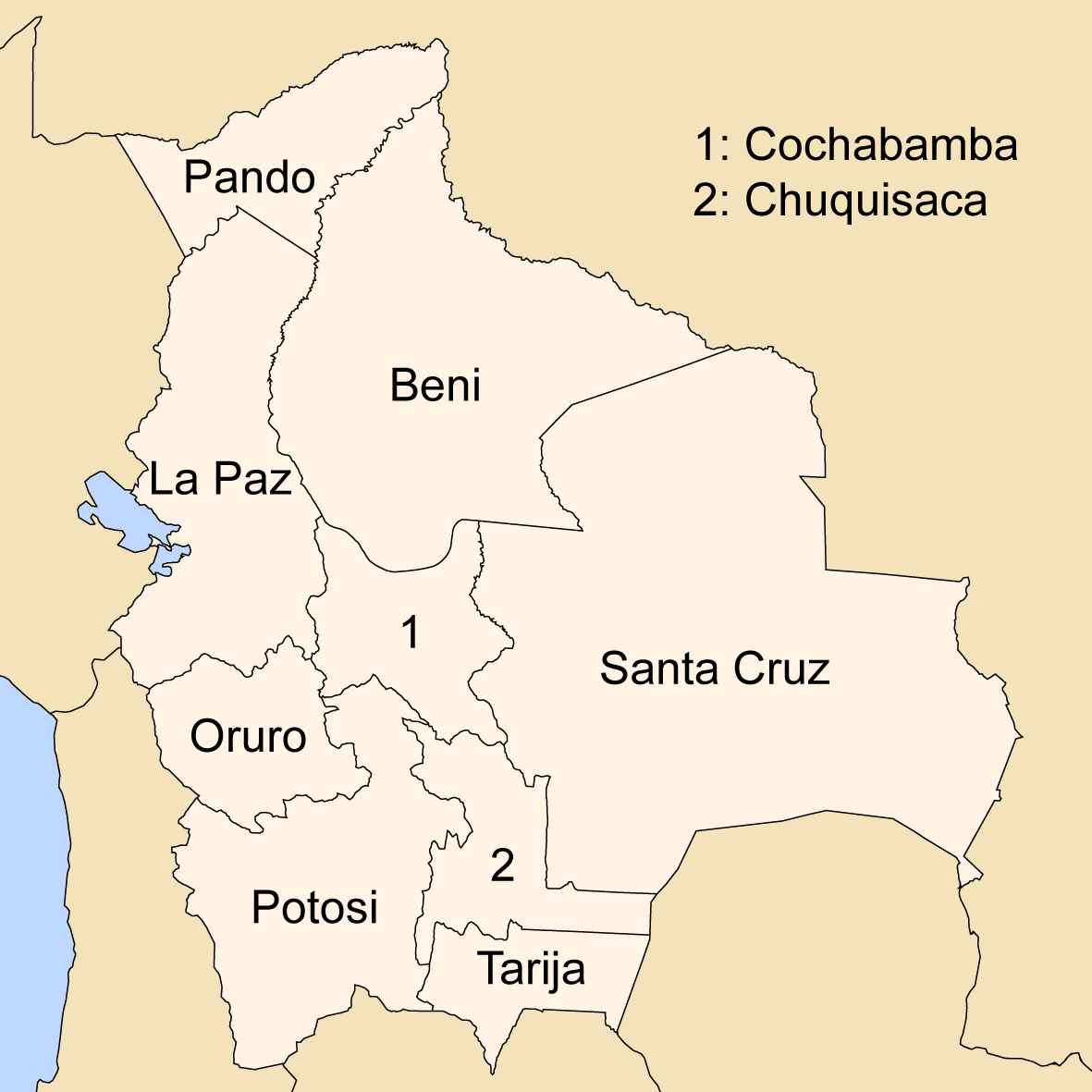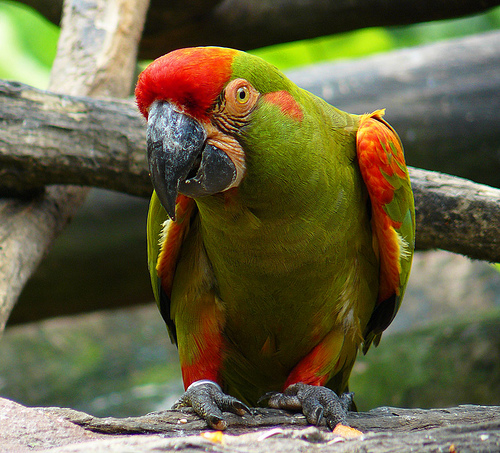|
Vila Vila Municipality
Vila Vila (in Hispanicized spelling) or Wila Wila (Aymara) is the second municipal section of the Mizque Province in the Cochabamba Department, Bolivia. Its seat is Vila Vila. Subdivision Vila Vila Municipality is divided into two cantons. See also * Chullpa Q'asa * Iskay Ch'utu * Jatun Urqu * Puka Qawiña Puka Qawiña (Aymara ''puka'' colored, ''qawiña'' gable, "red gable", also spelled ''Puca Cahuiña'') is a mountain in the Bolivian Andes. It is located in the Cochabamba Department, at the border of the Esteban Arce Province, Anzaldo Municipal ... * Tikrasqa References *Instituto Nacional de Estadistica de Bolivia (INE) External links Population data and map of Vila Vila Municipality Municipalities of the Cochabamba Department {{CochabambaBO-geo-stub ... [...More Info...] [...Related Items...] OR: [Wikipedia] [Google] [Baidu] |
Departments Of Bolivia
Bolivia is a unitary state consisting of nine department (administrative division), departments (). Departments are the primary subdivisions of Bolivia, and possess certain rights under the Constitution of Bolivia. Each department is represented in the Plurinational Legislative Assembly—a bicameralism, bicameral legislature consisting of the Senate and the Chamber of Deputies. Each department is represented by four Senators, while Deputies are awarded to each department in proportion to their total population. Out of the nine departments, La Paz Department (Bolivia), La Paz was originally the most populous, with 2,706,351 inhabitants as of 2012 but the far eastern department of Santa Cruz Department (Bolivia), Santa Cruz has since surpassed it by 2020; Santa Cruz also claims the title as the largest, encompassing . Pando Department, Pando is the least populated, with a population of 110,436. The smallest in area is Tarija Department, Tarija, encompassing . Departments Forme ... [...More Info...] [...Related Items...] OR: [Wikipedia] [Google] [Baidu] |
Cochabamba Department
Cochabamba (, , ), from Quechua ''qucha'' or ''qhucha'', meaning "lake", ''pampa'' meaning "plain", is one of the nine departments of Bolivia. It is known to be the " granary" of the country because of its variety of agricultural products from its geographical position. It has an area of 55,631 km2. Its population in the 2024 census was 2,005,373. Its capital is the city of Cochabamba, known as the "City of Eternal Spring" and "The Garden City" because of its spring-like temperatures all year. History The Cochabamba valley has been inhabited for over a thousand years due to its fertile productive soils and climate. Archaeological evidence suggests that the initial valley inhabitants were of various ethnic indigenous groups. Tiwanaku, Tupuraya, Mojocoya, Omereque and Inca inhabited the valley at various times before the Spanish arrived. The first Spanish inhabitant of the Valley was Garci Ruiz de Orellana in 1542. He purchased the majority of the land from local tribal ch ... [...More Info...] [...Related Items...] OR: [Wikipedia] [Google] [Baidu] |
Provinces Of Bolivia
A province is the second largest administrative division in Bolivia, after a department. Each department is divided into provinces. There are 112 provinces. The country's provinces are further divided into 337 municipalities which are administered by an alcalde and municipal council. List of provinces Beni Department Chuquisaca Department Cochabamba Department La Paz Department Oruro Department Pando Department Potosí Department Santa Cruz Department Tarija Department See also * Departments of Bolivia Bolivia is a unitary state consisting of nine department (administrative division), departments (). Departments are the primary subdivisions of Bolivia, and possess certain rights under the Constitution of Bolivia. Each department is represented ... * Municipalities of Bolivia Sources Instituto Nacional de Estadística - Bolivia(Spanish) {{Articles on second-level administrative divisions of South American countries Su ... [...More Info...] [...Related Items...] OR: [Wikipedia] [Google] [Baidu] |
Mizque Province
Mizque (from Quechua: ''misk'i'', meaning "sweet") is a province in the Cochabamba Department, Bolivia. Its capital is Mizque. The province, in 1992, had a population of 27,959 inhabitants, mostly indigenous citizens of Quechuan descent. In 2001, the population increased to 36,181 inhabitants and it was estimated at 41,062 in 2005. Geography Mizque Province is home to a great diversity of ecoregions because it contains a wide variety of topographic features with heights ranging between 2,000 and 3,600 m. The province belongs to the Julpe-Mizque basin with an area of 3,845 km2. The main rivers are: * Mizque River, 75 km * Julpe River, 60 km * Uyuchama River, 50 km * Tuqma River, 45 km * Kari Kari River, 42 km * Vicho Vicho River, 32 km Although there is a large amount of superficial and sub-superficial water within the province, the zone is suffering from drought due to the lack of irrigation systems. Some of the highest mountains of the ... [...More Info...] [...Related Items...] OR: [Wikipedia] [Google] [Baidu] |
Vila Vila
Vila Vila is a location in the Cochabamba Department in central Bolivia. It is the seat of the Vila Vila Municipality, the second municipal section of the Mizque Province Mizque (from Quechua: ''misk'i'', meaning "sweet") is a province in the Cochabamba Department, Bolivia. Its capital is Mizque. The province, in 1992, had a population of 27,959 inhabitants, mostly indigenous citizens of Quechuan descent. In 2001, .... References *Instituto Nacional de Estadistica de Bolivia (INE) Populated places in Cochabamba Department {{CochabambaBO-geo-stub ... [...More Info...] [...Related Items...] OR: [Wikipedia] [Google] [Baidu] |
Quechua People
Quechua people (, ; ) , Quichua people or Kichwa people may refer to any of the Indigenous peoples of South America who speak the Quechua languages, which originated among the Indigenous people of Peru. Although most Quechua speakers are native to Peru, there are some significant populations in Ecuador, Bolivia, Chile, Colombia, and Argentina. The most common Quechua dialect is Southern Quechua. The Kichwa people of Ecuador speak the Kichwa language, Kichwa dialect; in Colombia, the Inga people speak Inga Kichwa. The Quechua word for a Quechua speaker is ''runa'' or ''nuna'' ("person"); the plural is ''runakuna'' or ''nunakuna'' ("people"). "Quechua speakers call themselves Runa -- simply translated, "the people". Some historical Quechua people are: * The Chanka people lived in the Huancavelica Region, Huancavelica, Ayacucho Region, Ayacucho, and Apurímac Region, Apurímac regions of Peru. * The Huanca people of the Junín Region of Peru spoke Quechua before the Incas did. * ... [...More Info...] [...Related Items...] OR: [Wikipedia] [Google] [Baidu] |
Aymara Language
Aymara (; also ) is an Aymaran languages, Aymaran language spoken by the Aymara people of the Bolivian Andes. It is one of only a handful of Indigenous languages of the Americas, Native American languages with over one million speakers.The other native American languages with more than one million speakers are Nahuatl, Quechua languages, and Guarani language, Guaraní. Aymara, along with Spanish language, Spanish and Quechua language, Quechua, is an official language in Bolivia and Peru. It is also spoken, to a much lesser extent, by some communities in northern Chile, where it is a Minority language, recognized minority language. Some linguists have claimed that Aymara is related to its more widely spoken neighbor, Quechua languages, Quechua. That claim, however, is disputed. Although there are indeed similarities, like the nearly identical phonologies, the majority position among linguists today is that the similarities are better explained as areal feature (linguistics), areal ... [...More Info...] [...Related Items...] OR: [Wikipedia] [Google] [Baidu] |
Municipalities Of Bolivia
Municipalities in Bolivia () are administrative divisions of the entire national territory governed by local elections. Municipalities are the third level of administrative divisions, below departments and provinces. Some of the provinces consist of only one municipality. In these cases the municipalities are identical to the provinces they belong to. There are 340 municipalities. History of governance Municipalities in Bolivia are each led by a mayor, an executive office. Mayors were appointed by the national government from 1878 to 1942 and from 1949 to 1987. Local elections were held under the 1942 municipal code, which was in force until 1991. The 1985 Organic Law of Municipalities restored local elections for mayor and created a legislative body, the municipal council. In 1994, the entire territory of Bolivia was merged into municipalities, where previously only urban areas were organized as municipalities. As an effect of decentralization through the 1994 Law of Popular ... [...More Info...] [...Related Items...] OR: [Wikipedia] [Google] [Baidu] |
Bolivia
Bolivia, officially the Plurinational State of Bolivia, is a landlocked country located in central South America. The country features diverse geography, including vast Amazonian plains, tropical lowlands, mountains, the Gran Chaco Province, warm valleys, high-altitude Andean plateaus, and snow-capped peaks, encompassing a wide range of climates and biomes across its regions and cities. It includes part of the Pantanal, the largest tropical wetland in the world, along its eastern border. It is bordered by Brazil to the Bolivia-Brazil border, north and east, Paraguay to the southeast, Argentina to the Argentina-Bolivia border, south, Chile to the Bolivia–Chile border, southwest, and Peru to the west. The seat of government is La Paz, which contains the executive, legislative, and electoral branches of government, while the constitutional capital is Sucre, the seat of the judiciary. The largest city and principal industrial center is Santa Cruz de la Sierra, located on the Geog ... [...More Info...] [...Related Items...] OR: [Wikipedia] [Google] [Baidu] |
Vila Vila Canton
Vila may refer to: People *Vila (surname) Places Andorra * Vila, Andorra, a town in the parish of Encamp Brazil * Vila Bela da Santíssima Trindade, a municipality in the State of Mato Grosso * Vila Boa, Goiás, a municipality in the State of Goiás * Vila Flores, a municipality in Rio Grande do Sul * Vila Flor, a municipality in Rio Grande do Norte * Vila Império, a urbanized neighborhood in Minas Gerais. * Vila Lângaro, a municipality in Rio Grande do Sul * Vila Maria (district of São Paulo), a municipality in Rio Grande do Sul * Vila Nova do Piauí, a municipality of Piauí * Vila Nova dos Martírios, a municipality of Maranhão * Vila Nova do Sul, a municipality in Rio Grande do Sul * Vila Pavão, a municipality in Espírito Santo * Vila Propício, a municipality in the State of Goiás * Vila Rica, a municipality in the State of Minas Gerais * Vila Valério, a municipality in Espírito Santo * Vila Velha, a municipality in Espírito Santo Estonia * Vila, Estonia, vil ... [...More Info...] [...Related Items...] OR: [Wikipedia] [Google] [Baidu] |
Chullpa Q'asa
Chullpa Q'asa (Quechua ''chullpa'' stone tomb, burial tower, ''q'asa'' mountain pass, "''chullpa'' pass", also spelled ''Chullpa Khasa'') is a mountain in the Bolivian Andes. It is located in the Cochabamba Department, Mizque Province, Vila Vila Municipality Vila Vila (in Hispanicized spelling) or Wila Wila (Aymara) is the second municipal section of the Mizque Province in the Cochabamba Department, Bolivia. Its seat is Vila Vila. Subdivision Vila Vila Municipality is divided into two cantons. .... Chullpa Q'asa lies southwest of Jatun Urqu. References Mountains of Cochabamba Department Two-thousanders of the Andes {{CochabambaBO-geo-stub ... [...More Info...] [...Related Items...] OR: [Wikipedia] [Google] [Baidu] |

